-
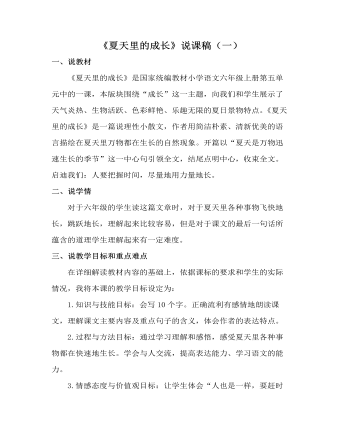
部编人教版六年级上册《夏天里的成长》说课稿(一)
二、说学情对于六年级的学生读这篇文章时,对于夏天里各种事物飞快地长,跳跃地长,理解起来比较容易,但是对于课文的最后一句话所蕴含的道理学生理解起来有一定难度。 三、说教学目标和重点难点 在详细解读教材内容的基础上,依据课标的要求和学生的实际情况,我将本课的教学目标设定为:1.知识与技能目标:会写10个字。正确流利有感情地朗读课文,理解课文主要内容及重点句子的含义,体会作者的表达特点。2.过程与方法目标:通过学习理解和感悟,感受夏天里各种事物都在快速地生长。学会与人交流,提高表达能力、学习语文的能力。3.情感态度与价值观目标:让学生体会“人也是一样,要赶时候,赶热天,尽量地用力地长。”的含义,从而懂得把握时间珍惜时间。
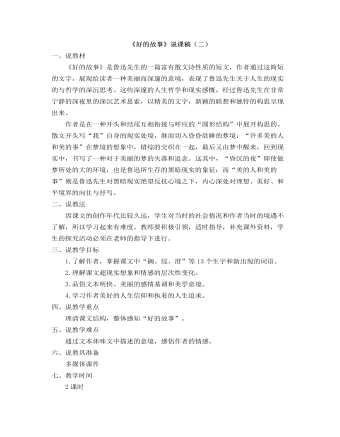
部编人教版六年级上册《好的故事》说课稿(二)
一、说教材《好的故事》是鲁迅先生的一篇富有散文诗性质的短文,作者通过这简短的文字,展现给读者一种美丽而深邃的意境,表现了鲁迅先生关于人生的现实的与哲学的深沉思考。这些深邃的人生哲学和现实感慨,经过鲁迅先生在非常宁静的深夜里的深沉艺术思索,以精美的文字,新颖的联想和独特的构思呈现出来。作者是在一种开头和结尾互相衔接与呼应的“圆形结构”中展开构思的。散文开头写“我”自身的现实处境,继而切入昏昏欲睡的梦境:“许多美的人和美的事”在梦境的想象中,错综的交织在一起,最后又由梦中醒来,回到现实中,书写了一种对于美丽的梦的失落和追念。这其中,“昏沉的夜”即使做梦所处的大的环境,也是鲁迅所生存的黑暗现实的象征;而“美的人和美的事”则是鲁迅先生对黑暗现实绝望反抗心境之下,内心深处对理想、美好、和平境界的向往与抒写。
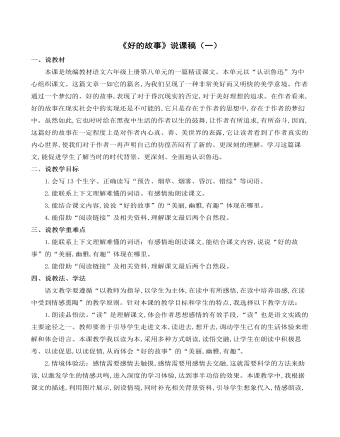
部编人教版六年级上册《好的故事》说课稿(一)
五、说教学过程 (一)谈话导入。 以学生平时的生活话题导入:同学们做过梦吗?谁能把自己做的美梦和大家分享一下?自然地提挈了文章内容,为学生理解课文做了铺垫。 (二)初读课文,扫清字词障碍。 让学生快速浏览课文,要求:读准字音,读通课文,遇到生字较多或难读的地方多读几遍,不理解的地方做上记号。 我再利用多媒体检查自学情况。课件出示生字词检查认读,抽查朗读。对易读错、写错的字让学生交流讨论识字方法,帮助识记。对难读的句子,交流朗读方法和要点,学生进行展示读。对难理解的词语,让学生利用学过的理解词语的方法交流讨论,理解意思。 (三)再读课文,整体感知。 请同学们自由朗读课文,思考:课文有几部分内容?重点写了什么? 明确文章的写作顺序和思路,引导分清层次,概括内容。根据学生的回答,适当提示总结,以梦境为中心展开,帮助概括内容。
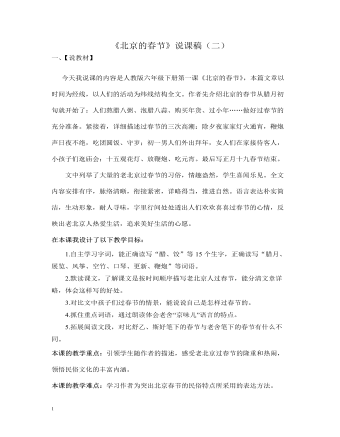
部编人教版六年级下册《北京的春节》说课稿(二)
一、【说教材】今天我说课的内容是人教版六年级下册第一课《北京的春节》,本篇文章以时间为经线,以人们的活动为纬线结构全文。作者先介绍北京的春节从腊月初旬就开始了:人们熬腊八粥、泡腊八蒜、购买年货、过小年……做好过春节的充分准备。紧接着,详细描述过春节的三次高潮:除夕夜家家灯火通宵,鞭炮声日夜不绝,吃团圆饭、守岁;初一男人们外出拜年,女人们在家接待客人,小孩子们逛庙会;十五观花灯、放鞭炮、吃元宵。最后写正月十九春节结束。文中列举了大量的老北京过春节的习俗,情趣盎然,学生喜闻乐见。全文内容安排有序,脉络清晰,衔接紧密,详略得当,推进自然。语言表达朴实简洁,生动形象,耐人寻味,字里行间处处透出人们欢欢喜喜过春节的心情,反映出老北京人热爱生活,追求美好生活的心愿。
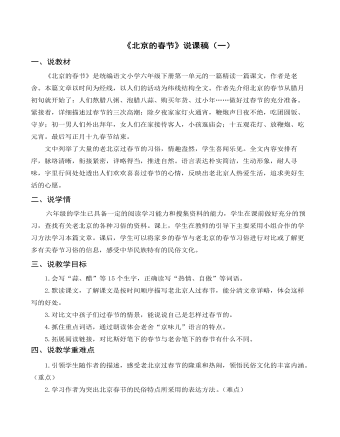
部编人教版六年级下册《北京的春节》说课稿(一)
二、说学情六年级的学生已具备一定的阅读学习能力和搜集资料的能力,学生在课前做好充分的预习,查找有关老北京的各种习俗的资料。课上,学生在教师的引导下主要采用小组合作的学习方法学习本篇文章。课后,学生可以将家乡的春节与老北京的春节习俗进行对比或了解更多有关春节习俗的信息,感受中华民族特有的民俗文化。三、说教学目标1.会写“蒜、醋”等15个生字,正确读写“热情、自傲”等词语。2.默读课文,了解课文是按时间顺序描写老北京人过春节,能分清文章详略,体会这样写的好处。 3.对比文中孩子们过春节的情景,能说说自己是怎样过春节的。 4.抓住重点词语,通过朗读体会老舍“京味儿”语言的特点。 5.拓展阅读链接,对比斯妤笔下的春节与老舍笔下的春节有什么不同。
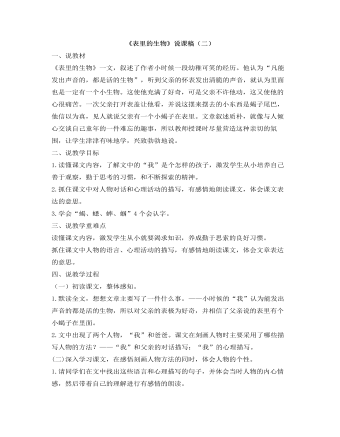
部编人教版六年级下册《表里的生物》说课稿(二)
一、说教材《表里的生物》一文,叙述了作者小时候一段幼稚可笑的经历。他认为“凡能发出声音的,都是活的生物”,听到父亲的怀表发出清脆的声音,就认为里面也是一定有一个小生物。这使他充满了好奇,可是父亲不许他动,这又使他的心很痛苦。一次父亲打开表盖让他看,并说这摆来摆去的小东西是蝎子尾巴,他信以为真,见人就说父亲有一个小蝎子在表里。文章叙述质朴,就像与人倾心交谈自己童年的一件难忘的趣事,所以教师授课时尽量营造这种亲切的氛围,让学生津津有味地学,兴致勃勃地说。二、说教学目标1.读懂课文内容,了解文中的“我”是个怎样的孩子,激发学生从小培养自己善于观察,勤于思考的习惯,和不断探索的精神。2.抓住课文中对人物对话和心理活动的描写,有感情地朗读课文,体会课文表达的意思。
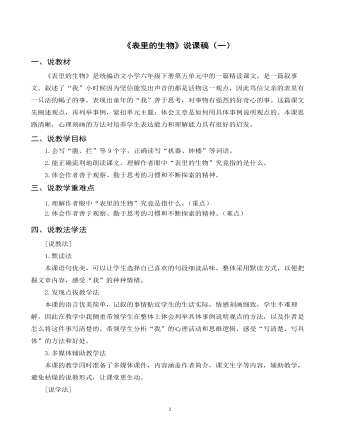
部编人教版六年级下册《表里的生物》说课稿(一)
一、说教材《表里的生物》是统编语文小学六年级下册第五单元中的一篇精读课文,是一篇叙事文。叙述了“我”小时候因为坚信能发出声音的都是活物这一观点,因此笃信父亲的表里有一只活的蝎子的事,表现出童年的“我”善于思考,对事物有强烈的好奇心的事。这篇课文先阐述观点,再列举事例,紧扣单元主题:体会文章是如何用具体事例说明观点的。本课思路清晰,心理刻画的方法对培养学生表达能力和理解能力具有很好的启发。二、说教学目标1.会写“脆、拦”等9个字,正确读写“机器、钟楼”等词语。 2.能正确流利地朗读课文。理解作者眼中“表里的生物”究竟指的是什么。 3.体会作者善于观察、勤于思考的习惯和不断探索的精神。三、说教学重难点1.理解作者眼中“表里的生物”究竟是指什么。(重点)2.体会作者善于观察、勤于思考的习惯和不断探索的精神。(难点)
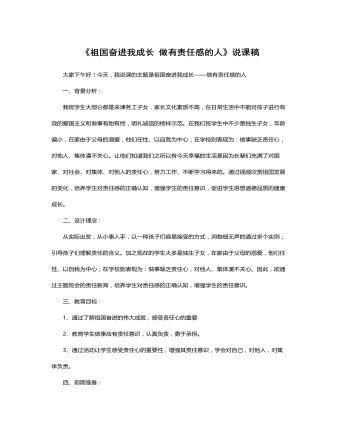
《祖国奋进我成长-做有责任感的人》说课稿
通过观看祖国变化的图片,了解祖国之所以有今天伟大的成就是因为有责任心的中国人凝聚在一起的爱国力量,是每个有责任心的人在自己的岗位上尽心尽力,出色的完成自己的任务。活动一:学生观看表现祖国各行各业奋进的演示文稿。活动二:观看建国六十周年国庆阅兵仪式的片断。活动三:学生代表二人交流:感受到的祖国的变化。活动四:学生交流:自己的感受。(二)理解责任的含义,认识不负责任的危害活动一:知道责任的含义:责任:就是分内应做的事情。也就是承担应当承担的任务,完成应当完成的使命,做好应当做好的工作。认真负责也是爱祖国的表现。责任感就是自觉地把分内的事做好的心情。活动二:通过观看我国航天领域的伟大成就,体验宇航员奋力拼搏,促进航天技术飞速发展的成功喜悦。活动三:通过故事《一个小数点酿成的悲剧》领悟出责任心的重要。了解不负责任的危害。活动四:学生讲出自己身边不负责任的事例。活动五:学生分享自己收获和感受。
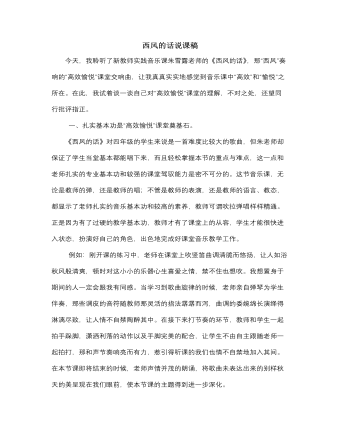
人音版小学音乐四年级下册西风的话说课稿
课堂上随机给出鼓励和肯定的语言更显教师的亲和力,营造出一个自由、民主的课堂教学氛围。如:“你很棒”“说得太好了”“掌声鼓励”等等,听似平淡无奇,但结合那时那景则显得老师语言的朴实与自然,学生同老师间的默契与和谐。听完朱老师执教的《西风的话》一课,通过认真反思我真切认识到:一堂好课是否愉悦高效,就看教师是否真正用心的地去诠释作品,真正用心地去备课。孙老师执教的《西风的话》平实、淡雅,教师教态自然大气,言谈中充满着激情,让我们的心不自觉跟着一起走。我想不出什么华丽的词藻来描述这堂课,但我却深深地被吸引,这应该就是生命课堂的魅力所在吧。听了孙老师执教的《西风的话》后收获很多,能于言表的也还没有表达充分,但更多的是带给我的触动和对自己所教学科如何“高效愉悦”的思索。也希望凭借着“高效愉悦”课堂活动的深入开展,让自己的美术课堂灵动起来,让我们的课堂真正成为孩子们探求知识的乐园。

初中英语外研版七年级下册《Module 5 Shopping》说课稿
二、教学目标1.知识与技能掌握下列单词:market, supermarket,biscuit, lemon, strawberry, Mother’s Day, size, take, may, try, try on,certainly, wait a minute, sale, price, sale, look. fresh2.过程与方法:1. 能够通过书面表达购物。2. 能够根据情景进行购物对话。3.情感态度与价值观:乐于参加运用英语的实践活动,了解别国文化。三、学习者特征分析这一模块内容的学习者,是七年级的学生。学生已经学过一些形式的特殊疑问句,像what can I do for you?/can I help you?这些购物句式 ,学生在学生在小学阶段已经学过,学生通过阅读,情景购物对话的练习,学生准确的进行购物的对话。

人教版高中英语必修1Anne's best friend说课稿
Step 7 Language points 1.Vocabulary (1) go through (2) set down (3) a series of (4) on purpose (5) in order to (6)at dusk (7)entirely (8)face to face 2.Important sentences (1)…I’ve grown so crazy about everything to do with nature. (2)There was a time when … (3)I stayed awake on purpose until … (4)It was the first time … that I’d seen the night … (5)It’s no pleasure looking through … Purpose: 1.Master the required vocabulary and sentence structures. 2.Use them freely. Step 8 Consolidation 1.Find out the topic sentences 2.Retell the text according to the topic sentences Purpose: I want to know if my students understand the text. Step 9 Discussion Imagine you have to go into hiding like Anne and her family, what would you miss most? Giveyour reasons. Purpose: Train Ss’ oral English ability. Step 10 Homework Write an article on Friends. Purpose: 1. Improve the Ss’ writing ability. 2 Train the Ss’ ability of self—teaching and looking up information by themselves. Part 5 Blackboard design(说板书设计)Unit 1 Friendship Reading Anne’s Best Friend 1.Main idea of each paragraph: Para. 1 Anne made her diary her best friend. Para .2 Anne wrote her feelings in her diary. Para .3 Anne missed nature. Para.4 Anne saw the night face to face Para.5 Anne wanted to experience nature outdoors. 2.Listening: Exx.1 P3 3.Discussion: Exx.3 P3 Purpose: 1.Make Ss familiar with the passage 2.Make the design inductive, instructive and artistic.

人教版高中英语必修2Computers说课稿3篇
一. 教材分析1. 本单元的中心话题是“计算机(Computers)”,内容涉及计算机的发展历史,计算机的应用等。本节课是该单元的第一课时,我将Warming up, Pre-reading and Comprehending这四部分整合为一节精读课。其中。Reading部分是题为WHO AM I?的文章,以第一人称的拟人手法介绍了计算机发长演变的历史和计算机在各个领域的应用,其主旨是表达计算机的发展变化之快以及在生活中用途之广。而Warming up部分以图片的形式展现了计算机的发展历程;Pre-reading中的问题和排序分别是为了预测语篇的内容和测试学生对计算机历史了解的情况;Comprehending则通过各项练习训练学生的阅读技能,从而加深对文章的理解。可见这几部分是一个有机的整体。2. 教学目标:1) 语言目标:重点词汇及短语:abacus, calculate, calculator, PC, laptop, PDA, robot, analytical, technological, universal, mathematical, artificial, intelligent, network, explore, in common, as a result.重点句子:a. My real father was Alan Turing, who in 1963 wrote a book to describe how computers could be made to work, and build a “universal machine” to solve any mathematical problem.

人教版高中英语必修2The Olympic Games说课稿2篇
Purpose of my design:To ask the students to do these two tasks will make the Ss predict the story of this passage. As a result, it will deepen Ss’ memory of this story because they will have their own understanding of this story.Step 3. While-readingTask 1. (Individual work _____min)Skimming: ask students to skim the text and the main ideas of each paragraph in this passage. Please read it quickly and then match the sentences with the letters.Task 2. (Individual work _____min)Scanning: read the text quickly and decide the whether the following statements are true or false and give reasons.Task 3. (Pair work _____min)Listen to the tape and fill in the banks. Then read the paragraph with expression to your partner.Task4 (individual work min)Listen to the tape again and write down the main idea in one sentence.Purpose of my design: Enable students to understand the given material better by using different reading skills. And proper competition can arouse the Ss’ interest in English learning. “Task-based” teaching method is used here todevelop the Ss’ ability of communication and also their ability of co-operation will be well trainedStep 4. Post-readingTask 1. (Individual work, pair work, group work, class work; _____min)Discussion (group of 4):1. If you were Hippomenes, would you run against Atlanta?2. Do you think Hippomenes deserved to win the race? Why or why not?Step 5. HomeworkPlease read the story again carefully after class and imagine: What will happen during the race between Hippomenes and Atlanta? Who do you think will win the race? Do you think Atlanta would marry Hippomenes? Write an end for the story with thses questions.Purpose of my design: Homework is so important and necessary for to master the knowledge they learned after class. It will check whether the Ss achieve the teaching aims.Part 5 Blackboard design

人教版高中英语必修4A taste of English Humor说课稿3篇
Then I would ask them to think of a funny English or Chinese and tell it to partners. While telling stories, they can use expressions and some acting to help make the story funny. 5 minutes would be given to do this.Those stories they told there will be the material for their writing. Soletting them tell it at first is helpful. And they can make a difference between telling a funny story and writing it down. Generally speaking, it is difficult forstudents to write well because they don’t know what to write and how to write. Asking them to tell their own stories at first can help them come up with what to write.After their telling, I would invite someone to share his/her story with all of us and I would write it down on the blackboard.This example story would be used as a sample to illustrate the format of funny story. Different from a story from teacher or textbook, a story from students can obviously become a interesting material to draw students’ attention.Then I would ask the whole class to put this story into several parts. It might be a little bit difficult for them. So I would ask them to find out whether all the sentences are necessary. After delete some sentences, there are 6 sentences left behind. Then they can easily put them into three parts. After interaction with students, I would teach them the right terms for each part and conclude the format of funny story.This step is the key and difficult point in my lesson. So I mainly usetask-based teaching method in this part and the task for students was divided into several stages. With the separated difficult level, students can find there are usually three parts in writing. They can also learn to write without the unnecessary parts in the process of analyzing. And then I wouldn’t rush to tell them the right terms to them directly. Instead, I would ask them to name them by their own. A confused mind is better for acquiring knowledge.While-writing:Then I would give students 7 minutes to write down this story, without other requirements.With all the preparations in pre-writing, students’ difficulties were cleared. So it would be much easier for them to write down the story within 7 minutes. There are no other requirements because students’ first writing is actually a drafting. It would be revise and edit several times later. Writing, as a skill

人教版高中英语必修3Festivals around the World说课稿3篇
Teaching plan for Unit 1 book3Good morning, teachers. It’s my great pleasure to be here because I can share my lesson with you and I can learn a lot from it. I’ll begin my lesson from the following four parts, the teaching material, the teaching methods, the studying methods and the teaching procedure.Firstly, let me talk about the teaching material. The content of my lesson is the reading passage festivals and celebrations of Unit 1 Festivals around the world. This passage is about festivals and celebrations. By studying this passage, we’ll enable the students to know that festivals exit everywhere, and many of festivals in different countries celebrate similar ideas. As we all know, the reading passage is the center of each unit. If the Ss can learn it well, it will be helpful to make the Ss learn the rest of this unit.After studying the teaching material, I think the teaching aims are as the followings:1. Knowledge aims:(1) The Ss can master the usage of the important words andexpressions.(2)The Ss can use the __________________ (grammar) in the proper situation.Make students know about the festivals all over the world and the detail of the festivals, such as origin, content, and the date of the holiday festivals.2. Ability aims:(1) Students can talk about festivals and celebrations in English(2) To improve the student’s reading ability, especially their skimming and scanning ability.3. Emotion aims:Make the Ss know about the foreign festivals, and respect other countries’ custom.Next, let’s come to the important points and the difficult points.The important point is how to make the Ss understand the text better and the difficult point is how can they talk about it. secondly, Teaching Methods:1. task-based Language Teaching2. Computer assisted language teaching.3. question-and–answer methodThirdly, Studying Methods:

人教版高中英语必修4Working The Land说课稿3篇
Knowledge objectives:(1) to make Ss grasp the usage of words, expressions and sentence structures: statistics, struggle, thanks to, rid of, some patterns for persuasion, the “ing” form as subject and object;(2)to use learnt knowledge to persuade sb.Ability objectives:(1) to develop Ss’ reading skills(skimming, scanning, word guessing);(2) to improve Ss’ speaking, communicating and cooperating skills.Emotional objectives:to make Ss know the contribution of Yuan,and learn his spirit and his simple life time.Teaching important and difficult points:(1) some words, expressions and sentence structures mentioned above;(2)the content of the text;(3)training their reading and speaking skills.Teaching methods: CLT, TBLT,QT.Learning strategies: CLS, QLS, TBLS.Teaching procedures:Step 1 lead-in: (1) teacher plays a piece of recent news from CCTV about the harvest of the super hybrid rice, and ask students whether they know Yuan or not, and talk about him and his contribution.(2)Brain storm: let Ss describe Yuan in their minds including his appearance, his living condition and so on.Step 2 fast reading tasks:(1)teacher introduces Yuan and super hybrid rice(2)make Ss read the text as fast as possible with questions. Such as: what’s the general ideaof this passage? What’s Yuan’ dream? (skimming and scanning skill)Step 3 intensive reading tasks(1)let Ss read the text silently, find topic sentence of each paragraph and draw the difficult sentences and the knowledge what they don’t understand.(words guessing)(2)teacher and Ss talk about the important words, expressions and sentences together, and ask Ss to retell the content of the text.(summarizing and paraphrasing)(3)teacher summarize this part.(4) read again following the courseware.

人教版高中英语必修5Great scientists说课稿4篇
通过写文章梗概,培养学生综合运用语言的能力,学习用恰当的英语描述科学家的故事。这是本课的教学难点。教师可以使用完形填空的方式来帮助学生整理语篇,从而来降低难度。本课的教学重点的突破方法是:在阅读前,让学生初步了解得出科学观点所需要的基本程序,从而轻松而自然地导入文章的阅读;在阅读过程中,由易到难设计快速阅读和精读的问题,层层推进各种阅读活动,让学生对阅读内容从整体感知到细节理解,最后深层读懂整篇文章,同时加强阅读策略的指导,让每个学生都主动参与课堂教学活动,最终达到提高阅读能力的目的。Step 4 Post-readingGroup Activities四人小组共同合作,在老师的适当指导下,就以下2个问题展开讨论,让学生就所知、所学、所感和所想融入话题,然后抽若干同学代表作小组发言。1. What do you think about John Snow, and what should we learn from him?2. Cholera was 19th century disease, which two diseases are similar to cholera today? Why?

人教版高中英语必修5The United Kingdom说课稿4篇
Teaching Aims:Knowledge 1. Get the students to learn the useful new words and expressions in this section. Aims:2. Let the students learn about how the UK was formed and the four groups of invaders.1. Develop students’ reading ability and let them learn different Ability reading skills. Aims:2. Enable students to learn to talk about the United Kingdom and the Union Jack Emotional 1. Let students know more about the UK2. Develop students’ sense of cooperative learning Aims:Teaching Important Points:1. Let the students learn about the countries of the United Kingdom and the Union Jack2. Get the students to read the passage and know about how the UK was formed and the four groups of invaders.3. Have the students learn different reading skills.Teaching Difficult Ponts:1. Develop students’ reading ability.2. Enable students to talk about the United Kingdom and the Union Jack.3. Let students learn how the UK was formed geographically and historically.Teaching Methods:Showing pictures, asking, exercising, listening, reading etc.Teaching Aids:A computer,a projector and a blackboard.Teaching Procedures: 1) Show a map of the world, ask students the following questions:Where is the UK?What’s the full name of the UK?2) Ask the students work in pairs to do the quiz on Page 9.Do you want to test how many things you know about the United Kingdom? Let’s have a small test.Using the map on P9, students answer the following questions:?How many countries does the UK consist of? What are they??England is divided into three main areas. Do you know what they are? 1) Scanning (10Minutes )Let the students hold the questions asked in pre-reading and read the passagequickly and then let them do the following exercise.Join lines to the right answer.
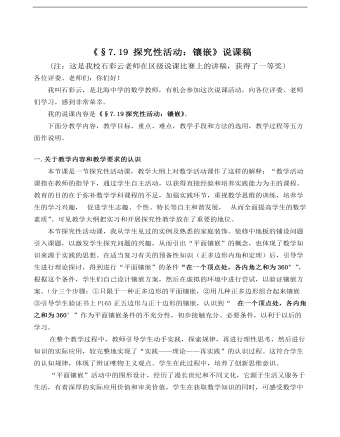
初中数学人教版八年级上册《719镶嵌》说课稿
一.关于教学内容和教学要求的认识 本节课是一节探究性活动课,教学大纲上对数学活动课作了这样的解释:“数学活动课指在教师的指导下,通过学生自主活动,以获得直接经验和培养实践能力为主的课程。教育的目的在于弥补数学学科课程的不足,加强实践环节,重视数学思维的训练,培养学生的学习兴趣,促进学生志趣、个性、特长等自主和谐发展, 从而全面提高学生的数学素质”。可见教学大纲把实习和开展探究性教学放在了重要的地位。
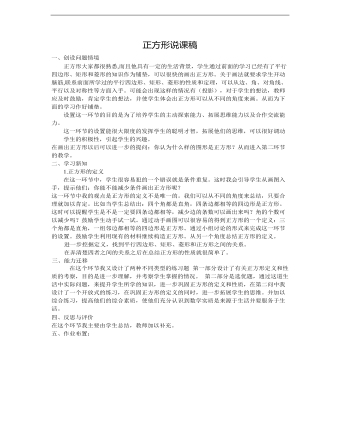
初中数学冀教版八年级下册《正方形》说课稿
二、学习新知1.正方形的定义在这一环节中,学生很容易犯的一个错误就是条件重复。这时我会引导学生从画图入手,提示他们:你能不能减少条件画出正方形呢?这一环节中我的观点是正方形的定义不是唯一的。我们可以从不同的角度来总结,只要合理就加以肯定。比如当学生总结出:四个角都是直角,四条边都相等的四边形是正方形。这时可以提醒学生是不是一定要四条边都相等,减少边的条数可以画出来吗?角的个数可以减少吗?鼓励学生动手试一试。通过动手画图可以很容易的得到正方形的一个定义:三个角都是直角,一组邻边都相等的四边形是正方形。通过小组讨论的形式来完成这一环节的设置。鼓励学生利用现有的材料继续构造正方形。从另一个角度总结正方形的定义。

